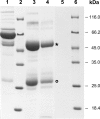Production of functionalized biopolyester granules by recombinant Lactococcus lactis
- PMID: 19465535
- PMCID: PMC2708441
- DOI: 10.1128/AEM.00487-09
Production of functionalized biopolyester granules by recombinant Lactococcus lactis
Abstract
Many bacteria are naturally capable of accumulating biopolyesters composed of 3-hydroxy fatty acids as intracellular inclusions, which serve as storage granules. Recently, these inclusions have been considered as nano-/microbeads with surface-attached proteins, which can be engineered to display various protein-based functions that are suitable for biotechnological and biomedical applications. In this study, the food-grade, generally-regarded-as-safe gram-positive organism Lactococcus lactis was engineered to recombinantly produce the biopolyester poly(3-hydroxybutyrate) and the respective intracellular inclusions. The codon-optimized polyhydroxybutyrate biosynthesis operon phaCAB from Cupriavidus necator was expressed using the nisin-controlled gene expression system. Recombinant L. lactis accumulated up to 6% (wt/wt) poly(3-hydroxybutyrate) of cellular dry weight. Poly(3-hydroxybutyrate) granules were isolated and analyzed with respect to bound proteins using biochemical methods and with respect to shape/size using transmission electron microscopy. The immunoglobulin G (IgG) binding ZZ domain of Staphylococcus aureus protein A was chosen as an exemplary functionality to be displayed at the granule surface by fusing it to the N terminus of the granule-associated poly(3-hydroxybutyrate) synthase. The presence of the fusion protein at the surface of isolated granules was confirmed by peptide fingerprinting using matrix-assisted laser desorption ionization-time of flight (mass spectrometry). The functionality of the ZZ domain-displaying granules was demonstrated by enzyme-linked immunosorbent assay and IgG affinity purification. In both assays, the ZZ beads from recombinant L. lactis performed at least equally to ZZ beads from Escherichia coli. Overall, in this study it was shown that recombinant L. lactis can be used to manufacture endotoxin-free poly(3-hydroxybutyrate) beads with surface functionalities that are suitable for biomedical applications.
Figures



References
-
- Amara, A. A., A. Steinbüchel, and B. H. A. Rehm. 2002. In vivo evolution of the Aeromonas punctata polyhydroxyalkanoate (PHA) synthase: isolation and characterization of modified PHA synthases with enhanced activity. Appl. Microbiol. Biotechnol. 59:477-482. - PubMed
-
- Bäckström, T. B., J. A. Brockelbank, and B. H. A. Rehm. 2007. Recombinant Escherichia coli produces tailor-made biopolyester granules for applications in fluorescence activated cell sorting: Functional display of the mouse interleukin-2 and myelin oligodendrocyte glycoprotein. BMC Biotechnol. 7:3. - PMC - PubMed
Publication types
MeSH terms
Substances
LinkOut - more resources
Full Text Sources

